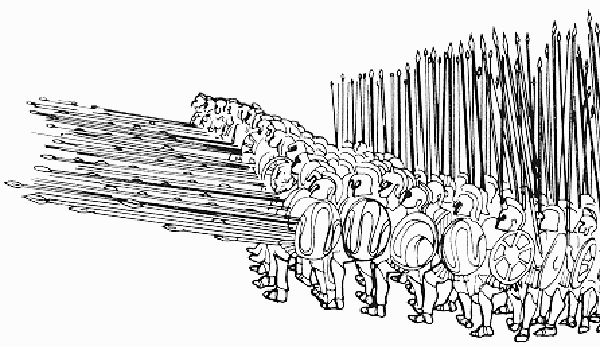Alexander the Great is well known for leading his armies to many victories as he battled through Europe. His armies weaponry however, differed from his enemies in its use of one particular weapon, the sarissa. The sarissa was a type of pike that was wielded with both great ability and efficiency by Alexander’s armies, and enabled his men to cut through an enemy army with ease.
Description of the Sarissa
The sarissa was a type of pike wielded by Alexander’s armies throughout his many battles through Europe. The sarissa differed from other pikes or long spears used commonly in Greece and nearby countries in its extraordinary length. Greek spear wielding soldiers, such as the Hoplites, wielded a 7 foot spear which had a reach of 4 feet with the wielder thrusting with one arm.
A sarissa wielder had a reach of up to 12 feet and used two hands to thrust, enabling him to put his full force behind the pike. The soldier was able to wield the sarissa with two hands as he made use of a smaller shield than other spear wielding soldiers. This smaller shield could be slung around the neck. Theophrastus, an ancient author of the time the sarissa was in use, wrote of the pike reaching up to 18 feet, although the exact length is still debated.
The sarissa was made of one unbroken shaft of wood so that it would withstand a charge from infantry or cavalry. The butt end of the spear was weighted with a spike to act as both a counter weight, and to drive into the ground to withstand a charge. The shaft of the sarissa was 1.5 inches thick and made of a hard elastic wood called cornel. The head of the weapon was 20 inches in length and weighed 2.7 pounds. In total, the the sarissa weighed more than any other spear in use. This heavy weight was offset by by a shield, and the absence of a breastplate to weigh down the soldier.
Effectiveness of the Sarissa in Battle
The sarissa was a highly specialized weapon that could only be used to maximum effectiveness through the use of strict formations such as the phalanx formation. The length and weight of the weapon made it too cumbersome for skirmishes, city fighting, or moving over mountainous terrain. A sarissa wielding infantry phalanx would have been 8 to 16 ranks deep. The long length of the sarissa meant that in these very close formations, 5-6 pike points protruded from the front line of the infantry towards oncoming troops, an intimidating sight for any opposing army.
An additional advantage of a sarissa wielding army was its low upkeep. Only one servant was required per ten men, which assisted the army as a whole in moving quickly from one conquest to the next. The speed of Alexander’s armies was such that some cities surrendered because they simply had not expected Alexander to arrive yet. The effectiveness of the sarissa and Alexander’s tally of victories was as much a psychological weapon as a physical one, as armies that saw the phalanx knew they were in for a battle they were unlikely to win.
Weaknesses of the Sarissa
Despite the influence the sarissa had over the course of many ancient battles, and the advantages it gave its army, the weapon was not without its limitations. Terrain had a significant bearing on its effectiveness, infantry could not effectively wield the weapon on uneven ground as it led to breaks in the line of pike points and made it difficult and dangerous for soldiers to move. Uneven terrain was far less of a disadvantage for infantry wielding shorter pikes.
A further weakness was that when fighting outside of the phalanx, a sarissa was rendered near useless in a skirmish, being too long and heavy to defend against a swordsman. Thus the sarissa was only appropriate for fighting in wide open plains where the use of formation and disciplined soldiers, and the physical advantages of the weapon could be utilized to maximum effect.
The phalanx was also vulnerable to attacks to the sides and rear during battle as the positioning of the sarissa made it difficult for the phalanx as a whole to combat an enemy than wasn’t directly in front. Soldiers would be butted in by pikes on either side, thus the phalanx needed to be defended by light infantry on its flanks.
Influence of the Sarissa
The sarissa was one of the most influential weapons of war in ancient times. It’s introduction into the Macedonian infantry was a significant factor in making Alexander’s armies the superior fighting force of ancient times, resulting in the massive empire of Alexander the Great. The weapons ability to decimate an oncoming army with minimal losses made the sarissa one of the most feared weapons of its time.
Sources:
- Arrian, The Campaigns of Alexander, Penguin Classics, (1971)
- Markle, M, “The Macedonian Sarissa, Spear, and related Armour”, American Journal of Archaeology , vol. 81, 1977
- Hammond, N.G.L. “Training in the Use of the Sarissa and its effect in battle, 359-333 B.C.”, Antichthon , vol. 14, 1980
- Mixter, J.R. “The length of the Macedonian sarissa during the reigns of Philip II and Alexander the Great”, The Ancient World , vol 23, no 2, 1992
- Manti, P.A. “The Sarissa of the Macedonian infantry”, The Ancient World, vol 23, no 2, 1992








